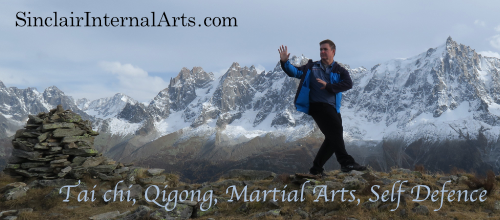Tai chi as a Martial Art
Tai chi is one of the most popular and most famous martial arts in the world. But it is also one of the least understood. There are innumerable stories about tai chi masters who, in spite of their size, age, or gender, have defeated opponents who were seemingly more formidable than they. But many people today, having only a passing understanding of the slow graceful movements of the tai chi form, see tai chi as “old people sneaking up on trees” and cannot conceive of it being effective for self defence.
Tai Chi Chuan belongs to a category of Chinese martial arts called “internal martial arts”. The primary focus is on the harmonious cultivation of mind, body, and spirit through the refinement of subtle internal alignment, the co-ordination of deep tissue, and the cultivation of qi (internal energy). Martial arts in the “External” category train these aspects also. But the order in which “internal” and “external” aspects are taught is different.
To practice any traditional martial art is to constantly seek balance and harmony within an inherently violent world. To create peace in our daily lives requires constant effort, and great skill. As long as we think, feel and breathe, then balance and peace will be elusive. We must seek them constantly or lose ourselves to war and death. When we wait for times of war to struggle for peace, it is like starting to dig a well when we are already thirsty. Likewise, if we wait until someone attacks us before we seek balance, we have already lost.
A physical attack is someone trying to upset our balance, by striking us, throwing us, or killing us. Balance cannot be maintained if it doesn’t exist in the first place. So, the martial artist cultivates physical, mental, emotional, and spiritual balance; and learns that these are all one and the same. When balance is strong, defending it is easy.
The masters who developed tai chi over several generations discovered that technique requires a method of application, and that method requires superior structure, agility, balance, and awareness. That is why tai chi training emphasizes slow movement and stillness over speed and force.
The student learns to stand, breath and move in a way that eliminates internal physical, mental, and emotional conflict. Only when one learns to stop fighting oneself can the opponent be effectively neutralized.
However, once the internal balance is achieved and the method of application is mastered, the plethora of martial techniques contained within the tai chi curriculum are sophisticated, efficient, and potentially devastating.
Is tai chi effective as a martial art?
There is a very good reason for the commonly held belief that tai chi players can’t fight their way out of a wet paper bag. It is because it is true! The majority of tai chi students care little about the art’s famous martial history. Most are in it for the well documented health benefits. Even so, while the martial aspect is hard to find, it is worth the search.
Is tai chi effective as a martial art?
Well, what it a martial art? Is it simply a way of defending oneself. In that case, the answer to the above question is a resounding qualified yes.
But there are a great many benefits to learning a martial art that go far beyond mere self defence or combat skill. Tai chi fits the bill here, also.
The effectiveness of any discipline or art form in achieving a particular goal is dependent on the student, the teacher, the relationship between the two, luck, timing, and more.
Every style of martial art from the ancient traditions of the Samurai to the modern so-called MMA styles of the UFC have two things in common. Both produce students who can defend themselves, and both produce students who couldn’t fight their way out of a wet paper bag even if they started on the outside.
Tai chi is a proven, profound, and effective martial art. But each student is different.
Tai chi chuan (Tai chi) is practised by millions around the world as a means to better health, fitness, and long life. What many do not know is that this relaxing and invigorating exercise is also practised by many as a martial art. Students who are seeking the physical, mental, and spiritual benefits of tai chi often do not want to learn the martial aspects of the art. So, most teachers do not teach the martial aspects. However, since the health benefits are a direct result of the art’s martial history, the best health benefits are achieved by learning from a teacher who at least understands the martial elements. The teacher doesn’t need to teach the student combat skills. But the teacher should understand them.
The masters who created tai chi chuan recognized how important it was for a martial artist to strengthen mind, body, and spirit. They also considered it self-evident that a martial artist should have a profound awareness of mind and body, and be skilled at constantly seeking peace and harmony in an inherently violent world.
These are essential qualities of high level martial artists. But they are also valuable for everyone else. That is why tai chi chuan exercises are part of China’s national fitness program, and have become immensely popular throughout the world.
Tai chi chuan has become so popular, in fact, that it has often been watered down and simplified to make it easier to teach to large masses of people. Today there are even many teachers don’t fully understand the true nature of the art. It is common for people today to see tai chi as nothing but a gentle exercise for old people. However, since the initial wave of popularity, the standards for teaching are increasing, and there are a growing number of schools endeavouring to teach the complete traditional art.
The complete tai chi system includes qigong, basic exercises, solo forms, two-person routines, tuishou, weapon training, martial applications, sanshou, and esoteric training methods.
Why do so few tai chi players develop the art’s legendary skills?
In fact, many tai chi players do have extraordinary skills, and can use tai chi effectively for self defence. But they are vastly outnumbered by those who do tai chi for health and recreation, ignoring the martial aspect of the art. In many ways, this is a good thing. The point of a martial art is to provide a remedy for violence, not to promote it. As more people find peace and relaxation in the daily practice of solo tai chi, perhaps they will be less prone to the errors in behaviour or awareness that can lead to violence in the first place.
First we learn to stop fighting ourselves. Then we learn to avoid fighting others. This is a skill that can be applied up to and including the application of actual martial techniques. Tai chi helps us find the best strategies, the best tactics, and the best mechanical advantages, whether engaged in combat or in the mundane functions of daily life.
The history of tai chi has a lot to do with the fact that modern tai chi schools seem to have little interest in practical self defence training.
In the late Qing Dynasty, when tai chi was taught outside of a private family lineage or a closed community, it was mostly taught to people who had already been doing martial arts for much of their lives. Most were already masters of other styles. They were not so much students as they were fellow teachers. Together they developed what was referred to as “Internal Arts.” This was not so much a martial style as it was a way of thinking. They refined the subtle principles of alignment, sensitivity, power, and strategy. While “internal” referred to the resulting power and awareness they achieved, it also referred to the fact that only advanced students were able to grasp the true meaning of the lessons. What this meant was that future generations of students, who learned these advanced principles for the sake of their health, might develop advanced martial skills, but they could never use these skills in a real fight because they lacked any previous martial arts foundation. It’s like having a Ferrari but not knowing how to drive.
Sometimes students develop skills they don’t know they have.
I often find myself teaching tai chi to students who have powerful aversions to learning martial arts. If I were to mention to them that tai chi is a martial art, they would leave the class. The reasons for this are varied. Some of my students are survivors of violence, and are learning tai chi to help with PTSD or similar trauma. Any talk of martial techniques can trigger them.
In the process of learning tai chi, however, they develop the methods, techniques, and strategies for movement that bring their mind and body into harmony with their environment, and this enables some to respond effectively to violence when it happens to them. Men and women have used skills learned in tai chi classes to deal effectively and instinctively with would-be purse snatchers, kidnappers, and other physical assaults. One student credited her tai chi training with being able to face down Central American bandits armed with AK-47s. (I told here that I didn’t remember teaching that class. But she was adamant that it was tai chi.)
Why is the tai chi form so slow?
If you can’t maintain ideal alignment and connection while you are moving slowly, you won’t be able to do it quickly. However, once you can do it slowly, speed is the easy part.
When do you speed it up?
Hardly ever. Even at the most advanced levels, the greatest improvement is achieved by moving even more slowly, or not at all.
How does that help in a fight?
A fight is all about balance and the integration of mind and body. If you don’t have balance, you have nothing to defend. If you have true balance, the fight is already won. The fastest way to reach a destination is to already be there.
Technique, Method, Sticking and Following
Technique
Each movement or part of a movement has three types of application:
Strike, Throw, and Lock
Method
Each position contains potential for 8 energetic qualities: “expansion,” “rolling,” “cramming,” “pressing,” “plucking,” “rending,” “folding” (elbow or knee), and “against” (shoulder or hip)
Each of these 8 qualities can be expressed in five ways:
“advance,” “retreat,” “focus,” “gaze,” and “root.”
The missing Element!
The ability to “stick & follow in a circle” is practised with an exercise called “tuishou” (pushing hands). This skill has uses in all ranges, but is most effective in the midrange.
With extraordinary mid-range skill, an athlete can find a noticeable advantage over those who lack it.
In the Middle of it All.
Mid-range skills are difficult to master and often frightening to practice. It is a range where everything is possible. That is why so few can use mid-range skills and why those who can are proven to have such a great advantage.
“I was just looking for the part of your mind that wanted to get knocked over.”
Vicky Hall
Core Principles.
We recognize that techniques don’t work if the method of application is incorrect. The method of application will not be effective if the structure and alignment of the body is not balanced and fluid. The structure will not be balanced and fluid if it is not relaxed. The structure cannot relax if the legs are not cooking. If, however, you can fry eggs on your thighs and relax the rest of the structure, we call it “having a solid root.” If you have a root, then technique is incidental.
Then you will be able to “stick and follow in a circle” (stay on target without letting the opponent find us). Next, we harmonize attack and defence and achieve a state called “no enemy.’

